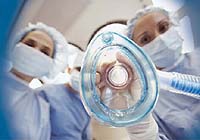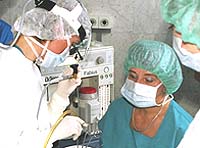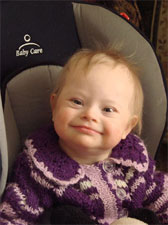What will happen if your child suffering from Hunter syndrome is assigned a procedure or operation requiring the use of anesthetics? How to take care of the child before and postoperative period? Read in this article.
Content
What is anesthesia
Anesthesia means loss of sensitivity, especially pain. Local anesthetic causes numbness only one local body part. The person in this body does not feel pain, but remains active and gives himself a report in what is happening.
When applied General anesthetics man is unconscious, unable to breathe and move, does not feel pain. To ensure the level of oxygen necessary to maintain life, it is necessary to supply air through the tube through the larynx in the trachea. The tube remains in the trachee during the entire operation and at the end it is removed before the patient's awakening.
Surgeon or one of the members of the doctor's team must explain what actions or procedures are scheduled. You will be asked to sign the official form of consent. You must ask questions if you do not fully understand what you give. If your child is able to understand the meaning of the procedure or operation, it may also be asked to sign the same form.
Anesthetist
 In most cases, children with Hunter syndrome must be operated in a major hospital with an experienced anesthetist pediatrician. For many surgical procedures, it is important to choose anesthesiologist even before the choice of the surgeon. It is necessary that anesthesiologist examined the child with Hunter syndrome in advance. The fact is that the child may die during the operation, if anesthesiologist does not take into account the characteristics of Hunter syndrome. First, it is an unusual (paradoxical) response to anesthetic (anesthetics), secondly, there is a big risk of suffocation due to the peculiarities of the respiratory tract, due to the deposition of mucopolysaccharides.
In most cases, children with Hunter syndrome must be operated in a major hospital with an experienced anesthetist pediatrician. For many surgical procedures, it is important to choose anesthesiologist even before the choice of the surgeon. It is necessary that anesthesiologist examined the child with Hunter syndrome in advance. The fact is that the child may die during the operation, if anesthesiologist does not take into account the characteristics of Hunter syndrome. First, it is an unusual (paradoxical) response to anesthetic (anesthetics), secondly, there is a big risk of suffocation due to the peculiarities of the respiratory tract, due to the deposition of mucopolysaccharides.
To avoid possible complications from the use of anesthesia in children with Hunter syndrome, you and your child's doctor must carry out a preoperative examination and an assessment of the effects of anesthetics, plan actions in case of unforeseen circumstances. To assess the degree of risk of potential problems during anesthesia, consultation of a cardiologist and a pulmonologist is necessary. Some children are afraid of injections, some poorly carry the smell of gas. Anesthesiologist must find the best method of anesthetic for your child.
Anesthesiologist should visit your child before surgery / procedure and prescribe the necessary drugs to prepare a child for anesthetic agent.
Sometimes parents accompany the child to the operating room and remain there until it falls asleep. If you feel it will help your child, you must discuss it with anesthesiologist.
Preparation for the operation
Abstinence from food
You must say that your child must have nothing to get anything and drinking anything (usually 4-6 hours). The fact is that if the stomach of the child is filled, during the use of anesthesia there is a risk of vomiting. So it is so important to free the belly before the start of the operation.
Medical preparation for operations are drugs that are given to the patient in front of a common anesthetic agent. They can change depending on the age of the patient and the type of operation. Some drugs are given to help the child relax, reduce the humidity in the mouth and throat to increase the effectiveness of the anesthetics, which will be given. Preparations are given through the mouth (orally), intravenously or intramuscularly in the thigh or buttock.
Anesthetic cream
If the anesthetic must be given intravenously, a special anesthetic cream can be applied on the needle administration site an hour before the start of the main anesthesia. It is important that the child does not feel the entry of the needle. Unfortunately, anesthetic cream acts only on the skin and does not help with intramuscular administration of anesthesia.
Expectation
Inform the brigade of doctors regarding the level of development of your child and his problems with vision and hearing. Bring glasses and hearing aids to help doctors communicate with your child. After the premedicated preparation for the operation, a child may have a feeling of dryness in the mouth. Some children can be irritable. Some children may have an attack of weakness in the legs. So for a child will be much safer if it will lie on the bed or sit with loved ones. If your child falls, it was best that he was lying on the bed or supported in a horizontal position, because if it remains in a vertical position, blood pressure can drop.
Sometimes the premedicated preparation for the child with Hunter syndrome may have a reverse effect - the child will be very energetic, and not drowned. If this happened earlier, you need to inform anesthesiologist about it. Also report about the preparation that has made such an effect. Do not forget to do it - the life of your child may depend on it. If you do not accompany the child in the operating room, you must discuss with a nurse when you better see the child before surgery. This will avoid unnecessary anxiety. Remember that you do not need to disturb the child at the last minute before the operation.
Movement with a child in operating
Nurse always accompanies the child in operating. In some hospitals, children allow you to take a favorite toy, a doll or blanket with you, however, it will be much better if you take it.
Before entering the operating room, you will be asked to put on special clothes and shoes. Anesthesiologist will explain to you the whole procedure that will be used for your child. As mentioned earlier, sometimes with intravenous administration anesthetic to the child preliminarily allowed to fall asleep or ask the child to breathe anesthetic to the mask. Anesthesia for young children can sometimes be on the knee of one of the parents, while the anesthetic gas tube will be supported near his face. As soon as your child is falling, you will be asked to leave. It is very important to go as soon as you ask you. Anesthesiologist should very quickly make a lot of things to ensure that your child is safely unbelievable.
When your child is in the operating room
At this time, many parents prefer to stroll or eat. If your child may need intensive postoperative therapy, you can ask doctors to inspect the cooked place in the room intensive therapy in advance. Many operations last longer than planned, and children usually hold a certain period of time in the room intensive therapy to recover before returning to a common chamber or discharge from the hospital. If you worry, you can ask for a nurse to check what your child does. In some hospitals, you will be allowed to visit the child in the room intensive therapy.
In the common ward
After applying anesthetic tools, your child can be drowned or be in a weak consumption, but the sound of your voice will help him relax and sleep more. The nurse will inform you when your child will safely drink anything.
Problems for children with Hunter syndrome
 Deposits of glycosaminglikanov (mucopolysaccharides) in all tissues (for example, nose, almonds, adenoids, throat, trachea, heart), their effect on the formation of bones makes the use of anesthesia. These sediments narrow nasal passages, increase almonds, adenoids and language, and are the cause of free excess tissues forming around the larynx. These problems strongly limit the inspection of the larynx with the help of a laryngoscope (a medical device for inspection of the pharynx cavity). When relaxing muscles, in the process of premedicate preparation or general anesthesia, the obstruction (degree of obstruction) of the respiratory tract increases. In addition, the rigid occipital spinal ridge with an insufficiently durable spine does not allow anesthesiologist to post a head and neck in this position to better consider the larynx. Limited jaw movement, short neck and thick mucous makes the larynx examination even a very qualified anesthesiologist. There are other factors that increase the risk of anesthesia - for example, thick skin and contractures (painful abbreviation of the muscle with restriction of joint mobility) joints make difficult intravenous access, especially in an emergency. The deposits of glycosamingles in the heart and blood vessels also contributes to an increase in risk, however, the risks associated with the heart and blood vessels are much less compared to the problems of the respiratory tract.
Deposits of glycosaminglikanov (mucopolysaccharides) in all tissues (for example, nose, almonds, adenoids, throat, trachea, heart), their effect on the formation of bones makes the use of anesthesia. These sediments narrow nasal passages, increase almonds, adenoids and language, and are the cause of free excess tissues forming around the larynx. These problems strongly limit the inspection of the larynx with the help of a laryngoscope (a medical device for inspection of the pharynx cavity). When relaxing muscles, in the process of premedicate preparation or general anesthesia, the obstruction (degree of obstruction) of the respiratory tract increases. In addition, the rigid occipital spinal ridge with an insufficiently durable spine does not allow anesthesiologist to post a head and neck in this position to better consider the larynx. Limited jaw movement, short neck and thick mucous makes the larynx examination even a very qualified anesthesiologist. There are other factors that increase the risk of anesthesia - for example, thick skin and contractures (painful abbreviation of the muscle with restriction of joint mobility) joints make difficult intravenous access, especially in an emergency. The deposits of glycosamingles in the heart and blood vessels also contributes to an increase in risk, however, the risks associated with the heart and blood vessels are much less compared to the problems of the respiratory tract.
What can be done?
Your child with Hanter syndrome has increased risk of anesthetic. Therefore, it is safe to carry out a procedure in a large hospital having experience with children with Hunter syndrome, even if you need to go to another city or region. Your child may have the need to stay with a special tube inserted into the larynx and the trachea, on the breathing apparatus for some time after the operation. Thus, your child needs a hospital with increased pediatric care. Outpatient treatment is not suitable!
If you are worried about the proposed operation, discuss it with your pediatrician and genetic. They can offer to be examined elsewhere. The risks of anesthesia and the benefits of the operation should be strictly weighed. Make sure the anesthesiologist knows the condition of your child and possible problems. Steps may be taken to make the process more secure - rejection of specific anesthetics or stabilization of neck in patients with problems of the occipital spine. Local anesthesia can be selected for some procedures. If the patient has a significant risk associated with anesthesia, it is in many cases it is possible to determine before the operation. Pulmonologist and cardiologist may be useful. The pulmonologist can recommend the study of sleep and a pulmonary test. The pulmonologist can estimate the anatomy of the respiratory tract using a flexible bronchoscope.
Since the patients with Hunter syndrome have obstruction of the respiratory tract, which can lead to the impossibility of intubating or other conventional methods. In this case, you can use alternative methods. To skip the breathing tube in the trachea at the beginning of the procedure, a flexible bronchoscope can be used. Or you can use a minor respiratory path in combination with a flexible bronchoscope. However, these methods require that anesthesiologist has experienced their use.









